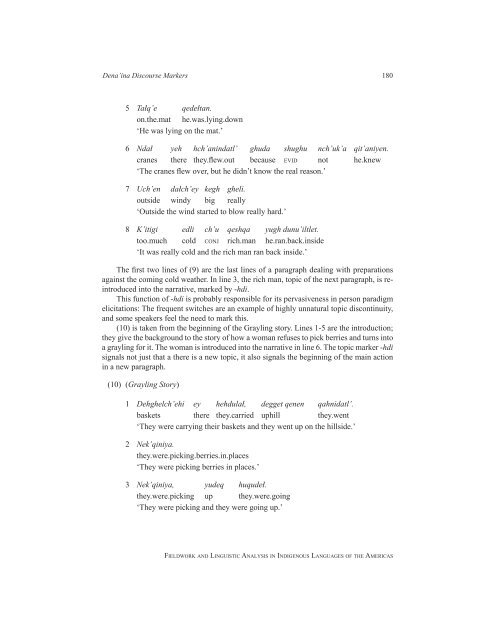Fieldwork and Linguistic Analysis in Indigenous ... - ScholarSpace
Fieldwork and Linguistic Analysis in Indigenous ... - ScholarSpace
Fieldwork and Linguistic Analysis in Indigenous ... - ScholarSpace
You also want an ePaper? Increase the reach of your titles
YUMPU automatically turns print PDFs into web optimized ePapers that Google loves.
Dena’<strong>in</strong>a Discourse Markers 180<br />
5 Tałq’e qedełtan.<br />
on.the.mat he.was.ly<strong>in</strong>g.down<br />
‘He was ly<strong>in</strong>g on the mat.’<br />
6 Ndał yeh hch’an<strong>in</strong>datl’ ghuda shughu nch’uk’a qit’aniyen.<br />
cranes there they.flew.out because evid not he.knew<br />
‘The cranes flew over, but he didn’t know the real reason.’<br />
7 Uch’en dałch’ey kegh gheli.<br />
outside w<strong>in</strong>dy big really<br />
‘Outside the w<strong>in</strong>d started to blow really hard.’<br />
8 K’itigi edli ch’u qeshqa yugh dunu’iltlet.<br />
too.much cold conJ rich.man he.ran.back.<strong>in</strong>side<br />
‘It was really cold <strong>and</strong> the rich man ran back <strong>in</strong>side.’<br />
The first two l<strong>in</strong>es of (9) are the last l<strong>in</strong>es of a paragraph deal<strong>in</strong>g with preparations<br />
aga<strong>in</strong>st the com<strong>in</strong>g cold weather. In l<strong>in</strong>e 3, the rich man, topic of the next paragraph, is re<strong>in</strong>troduced<br />
<strong>in</strong>to the narrative, marked by -hdi.<br />
This function of -hdi is probably responsible for its pervasiveness <strong>in</strong> person paradigm<br />
elicitations: The frequent switches are an example of highly unnatural topic discont<strong>in</strong>uity,<br />
<strong>and</strong> some speakers feel the need to mark this.<br />
(10) is taken from the beg<strong>in</strong>n<strong>in</strong>g of the Grayl<strong>in</strong>g story. L<strong>in</strong>es 1-5 are the <strong>in</strong>troduction;<br />
they give the background to the story of how a woman refuses to pick berries <strong>and</strong> turns <strong>in</strong>to<br />
a grayl<strong>in</strong>g for it. The woman is <strong>in</strong>troduced <strong>in</strong>to the narrative <strong>in</strong> l<strong>in</strong>e 6. The topic marker -hdi<br />
signals not just that a there is a new topic, it also signals the beg<strong>in</strong>n<strong>in</strong>g of the ma<strong>in</strong> action<br />
<strong>in</strong> a new paragraph.<br />
(10) (Grayl<strong>in</strong>g Story)<br />
1 Dehghelch’ehi ey hehdulał, degget qenen qahnidatl’.<br />
baskets there they.carried uphill they.went<br />
‘They were carry<strong>in</strong>g their baskets <strong>and</strong> they went up on the hillside.’<br />
2 Nek’q<strong>in</strong>iya.<br />
they.were.pick<strong>in</strong>g.berries.<strong>in</strong>.places<br />
‘They were pick<strong>in</strong>g berries <strong>in</strong> places.’<br />
3 Nek’q<strong>in</strong>iya, yudeq huqudeł.<br />
they.were.pick<strong>in</strong>g up they.were.go<strong>in</strong>g<br />
‘They were pick<strong>in</strong>g <strong>and</strong> they were go<strong>in</strong>g up.’<br />
fieldwork <strong>and</strong> l<strong>in</strong>guistic analysis <strong>in</strong> <strong>in</strong>digenous languages of the americas

















